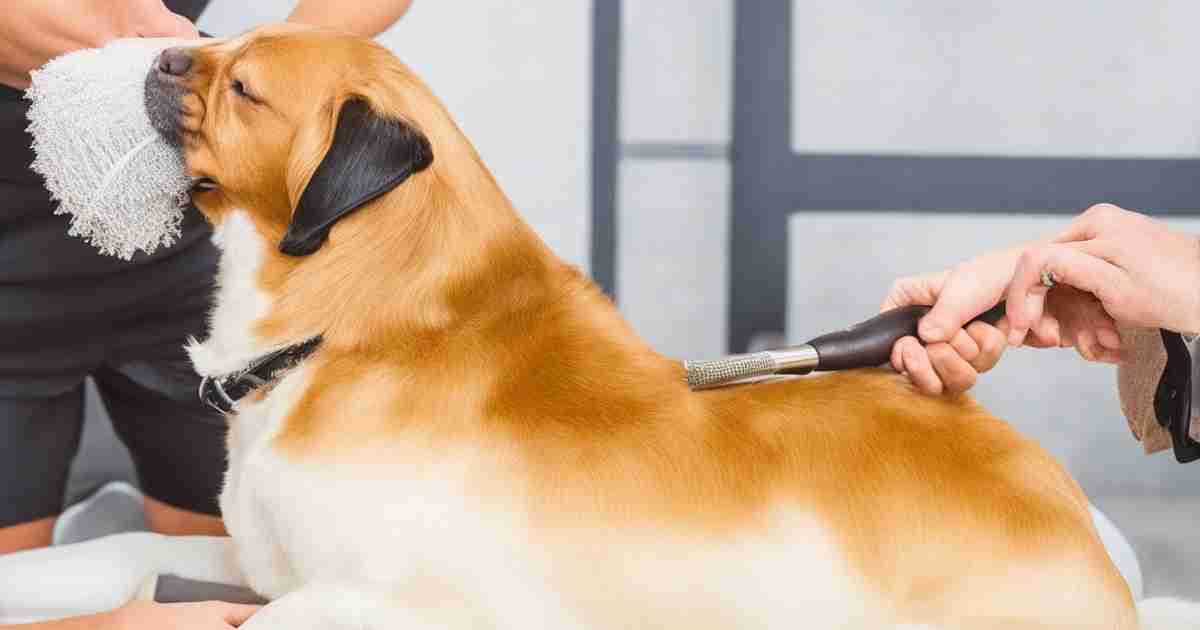The Rottweiler Labrador Retriever mix, also known as a Labrottie or Rottador, is a popular hybrid dog breed that combines the heritage of two beloved purebreds – the Labrador Retriever and the Rottweiler. This crossbreed likely originated in the 1990s or early 2000s along with the rise in popularity of designer dogs.
While purebred Rottweilers and Labradors have long histories as working dogs with jobs like herding, hunting, and retrieving, Rottweiler Lab mixes are primarily companion dogs. They make excellent family pets that are loyal, friendly, and highly trainable when properly socialized.
One of the top considerations for prospective Rottador owners is the lifespan of these dogs and what health issues they may face. On average, a healthy Rottweiler Lab mix can live 10-12 years. This represents a slight improvement over the average lifespan of purebred Rottweilers, which is 8-10 years.
Some of the most common health problems seen in Rottweiler Labs include:
- Hip and elbow dysplasia
- Eye diseases like PRA and cataracts
- Heart disease
- Obesity
- Skin allergies
- Bloat
Proper care and prevention measures can help reduce the chances of these issues occurring and allow your dog to live a longer, healthier life.
In this comprehensive guide, we will cover all aspects of Rottweiler Lab lifespan and health, including:
- Average lifespan and longevity factors
- Personality and ideal households for this mix
- Exercise needs and living conditions
- Appearance, coat, colors, and grooming
- Choosing a breeder and puppy costs
- Training and care for Rottweiler Lab puppies
- Nutrition and feeding recommendations
- Health screening and disease prevention
- Frequently asked questions about this popular mixed breed
By understanding the lifespan, health concerns, and care requirements of the Rottador, you can make the most informed choice about whether this dog will fit your lifestyle. Read on for more details on ensuring your Rottweiler Lab mix lives a long, healthy, and happy life!
Lifespan of a Rottweiler Labrador Retriever Mix
One of the most common questions owners have about Rottweiler Lab mixes is – how long will my dog live? Understanding the average lifespan and longevity factors allows you to set appropriate expectations and make sure you can provide the proper care over your dog’s lifetime.
What is the Average Lifespan of a Rottweiler Lab Mix?
The typical lifespan of a healthy Rottador ranges from 10-12 years. This represents a slight increase over the average lifespan of a purebred Rottweiler, which is 8-10 years.
Labrador Retrievers generally live 10-12 years as well, so the Rottweiler Lab cross seems to benefit from the hybrid vigor that often occurs in mixed breeds. The diverse gene pool increases overall constitutional strength.
Of course, lifespan varies quite a bit from dog to dog based on a number of factors. Your own Rottweiler Lab could pass away earlier or live longer than these averages.
What Impacts the Lifespan of a Rottweiler Lab?
While the exact lifespan of any dog depends partly on chance, there are certain variables that affect longevity:
Size
- Larger dogs tend to have shorter lifespans
- Rottweiler Labs range from 65-110 lbs when fully grown
- Keeping your dog lean can help reduce issues tied to size
Health
- Dogs with chronic illnesses or genetic diseases may have reduced longevity
- Health screening and preventative care is key
- Proper treatment of any issues that arise is important
Nutrition
- Obesity leads to many life-shortening illnesses
- Stick to a healthy, portion-controlled diet
- 2-3 meals per day and limited treats
Exercise
- Lack of activity can cause obesity and joint problems
- Active Rottador dogs tend to stay healthier
- Aim for at least 60 minutes of exercise daily
Socialization & Training
- Well-adjusted dogs have less stress and anxiety
- Proper training makes them better companions
- Socialization prevents behavioral problems
Regular Veterinary Care
- Annual exams allow early detection of any issues
- Vaccines prevent contagious diseases
- Dental cleanings reduce risk of infections
Genetics
- Some dogs are predisposed to certain conditions
- Health testing breeders reduces risk of inheriting diseases
- But unknown factors can affect individuals too
By focusing on the variables you can control, you have the best chance of maximizing your Rottweiler Lab’s life expectancy.
How Does Lifespan Compare to the Parents?
We know the typical Rottweiler lives 8-10 years, while the typical Lab lives 10-12 years. Since Rottweiler Labs generally fall right between the two, averaging 10-12 years, it indicates they benefit from the hybrid vigor that often occurs when crossing two purebreds.
Some speculate that the reason purebreds have reduced longevity compared to mixed breeds is due to closed gene pools. After many generations of purebred dogs only being bred to others of their same breed, the gene pool narrows, increasing the chances of inheriting flawed genes that lead to chronic illness or early death.
Crossing two different purebreds introduces new genes outside what is available within a single breed. This has the effect of strengthening the constitution of the offspring, improving overall health and longevity. It’s the best of both worlds!
Of course individuals can vary quite a bit. Some Rottweiler Labs tragically pass away earlier than expected due to accidents or illnesses. But your chances of having one of the longer-lived specimens are pretty good if you take excellent care of your dog’s health and wellbeing.
How to Maximize Your Rottweiler Lab’s Lifespan
While we can’t control everything about our dogs’ longevity, providing the very best care from puppyhood onwards gives them the best shot at a long life. Here are some tips:
- Select a breeder who screens for health risks
- Maintain preventative care like flea/tick/heartworm medications
- Stick to a healthy diet and don’t overfeed treats
- Ensure your dog gets plenty of exercise each day
- Stimulate your dog’s mind through training and toys
- Socialize thoroughly and attend training classes
- Address any emerging health issues promptly
- Brush teeth and provide routine dental cleanings
- Visit the vet for wellness exams 1-2 times per year
- Keep your dog lean and fit; measure food carefully
The average Rottweiler Lab mix lifespan is 10-12 years, but giving your beloved Rottador the very best care from the start will help maximize the chances they reach the long end of that range!
Common Health Issues in Rottweiler Labs
Alright, this is the not-so-fun part where we talk about everything that can go wrong with your favorite Rottweiler Lab mix. I know, I know, reading about health problems is a total downer. But it’s important we have an honest chat about it so you know what you might be dealing with. Don’t worry, I’ll try to make it as painless as possible!
First off, let’s bust a myth – mixed breed dogs are not free of all the genetic conditions of their parent breeds. I wish it worked that way, but it just isn’t true. That said, crosses do tend to be healthier overall thanks to that lovely hybrid vigor we talked about earlier.
So while your Rottador still needs some screening and prevention, chances are the risks are reduced compared to a purebred Lab or Rottie. Not bad!
Alright, let’s look at some of the most common health issues reported in Rottweiler Labs:
Hip and Elbow Dysplasia
This nasty condition is unfortunately far too common in big breeds, including Labs and Rottweilers. It occurs when the hip or elbow joint doesn’t form correctly, causing arthritis, lameness, and mobility issues. Not fun!
- Many dogs show signs as young adults, but it can happen at any age
- Diagnosis via X-ray screening is recommended for at-risk breeds
- Treatment ranges from medication to surgery for severe cases
- Keeping your dog lean takes pressure off joints
- Supplements like glucosamine can provide some relief
Dysplasia is primarily genetic, but environmental factors like diet and exercise also play a role. Go with breeders who screen parent dogs and focus on joint-friendly care.
Eye Diseases
Labs and Rotties are both prone to certain eye conditions, including:
- PRA – Progressive retinal atrophy that causes vision loss
- Cataracts – Clouding of the lens that leads to eventual blindness
- Annual eye exams by your vet allow early detection
- PRA is genetic – should be screened by breeders
- Cataract surgery can restore vision if caught early enough
- Protect your dog’s eyes from UV damage outside
Vision problems are no fun for dogs, so be vigilant about eye health!
Heart Disease
Cardiac issues are a concern for Rottweilers especially:
- Subvalvular aortic stenosis – Abnormality of the aortic valve
- Dilated cardiomyopathy – Enlarged, weakened heart muscle
- Can cause fainting, lethargy, rapid breathing, coughing
- Diagnosed via cardiac exam, EKG, chest x-rays
- Various medications used to manage symptoms
- Limit sodium intake and maintain ideal weight
Make sure your breeder screens for heart conditions. Follow up with routine vet checks.
Obesity
I hate to say it, but too many adorable Rottie Labs are fat!
- Excess weight strains the joints, heart, and other organs
- Measure food carefully and limit treats
- Ideal body condition = lean with tucked waist, ribs felt but not seen
- Exercise regularly – swimming and walking are joint-friendly
Help your best friend stay fit and avoid obesity-related diseases!
Skin Problems
Labs and Rotties get itchy sometimes:
- Allergies – Reaction to food or environmental triggers
- Yeast – Fungal infections in moist folds of skin
- Hot spots – Bacterial infections in moist areas
- Identify and avoid allergy triggers if possible
- Antibiotics, antifungals, medicated shampoos provide relief
- Prevent excessive moisture and keep skin clean
- Antihistamines help control itching and inflammation
Don’t let your pup scratch themselves raw – treat skin issues promptly!
Bloat
This scary condition needs emergency surgery:
- Gastric dilation volvulus – Stomach swells then twists or rotates
- Big meals, active play after eating increase risk
- Symptoms are unsuccessful vomiting, distended abdomen
- Immediate vet visit is required! Surgery is often needed
- Feed smaller meals rather than one large portion
- Rest for 1 hour after eating before vigorous play
Bloat strikes suddenly and moves quickly. Know the signs and respond fast!
Whew, that’s a lot of medical mumbo jumbo to digest! The main takeaway is that while crosses are generally pretty healthy thanks to that hybrid vigor magic, risks still exist. Work with responsible breeders, stay vigilant about preventative care, and address any issues promptly.
If we keep our eyes open and take prompt action, our Rottweiler Lab can hopefully avoid most of these unpleasant health issues and stick around for a good long time. They deserve nothing less!
Now go give your good dog some belly rubs. I think we’ve earned ’em after all that heavy stuff!
Personality and Temperament of the Rottweiler Lab Mix
Alright, this is one of my favorite parts – talking about what wonderful companions these Rottweiler Lab mixes can be! But fair warning, we need to chat about their protective instincts too. Sound good? Let’s dig in.
First up, you should know Rottadors are extremely loving and affectionate with their families. I mean, have you seen anything cuter than a Rottie Lab mix puppy?? Those big ol’ paws, that fuzzy tummy, the oversized ears – ADORABLE.
Even as they grow up, that loving loyalty remains. You’ll have a constant companion who wants nothing more than to hang out with their favorite humans. Could you ask for a better BFF?
Playful Family Member
Rottweiler Labradors thrive when they’re part of the action. These dogs want to be where the family is, joining in whatever fun is happening.
- Energetic and playful, especially as younger dogs
- Enjoy games like fetching balls or frisbees
- Love splashing around in water on warm days
- Always down for tug-of-war or wrestling matches
- Make great adventure buddies – excellent swimmers and hikers
Include your Rottador in family activities and they’ll reward you with endless enthusiasm and silly antics. It’s impossible not to smile around these goofballs!
Protective Instincts
Now for the serious stuff. As the offspring of two guarding breeds, the Rottweiler and Labrador Retriever mix needs proper socialization to keep their protective instincts in check.
Rotties were bred as guardians and defenders, while Labs worked cooperatively alongside their owners. So a Rottador could end up anywhere along the spectrum from wary watchdog to friendly companion.
- May be reserved or aloof with strangers
- Some exhibit aggressive barking or growling
- Strong instinct to guard territory and family members
- Require extensive exposure to people as puppies
- Obedience training helps reinforce proper behavior
Without careful socialization as a pup, an unsocialized Rottweiler Lab risks becoming an anxious or reactive adult dog. Definitely not what we want!
Smart and Eager to Please
Luckily, these hybrids are extremely intelligent and trainable when raised with dedication and patience. In fact, well-socialized Rottadors make wonderful family pets precisely because they pick up on cues so quickly.
- Respond readily to positive reinforcement
- Food rewards are great motivators during training
- Aim to start puppy kindergarten by 12 weeks of age
- Practice basic commands daily – sit, stay, come, heel
- Puzzle toys provide important mental stimulation
Put in the effort during your dog’s formative months and you’ll be rewarded with years of companionship from an obedient, well-adjusted big friendly pup.
Exercise Needs
Gotta work off all that smart energy! As the offspring of two active working breeds, the Rottweiler cross Labrador has some substantial exercise requirements:
- 60+ minutes of activity per day is recommended
- Mix of walking, running, swimming, playing
- Fetching balls or frisbees is a great workout
- Walking nicely on leash is an important skill to master
- Backyard time alone doesn’t equal real exercise
- Puppy exercise should be limited to avoid joint damage
Mentally drained dogs are less likely to get into mischief or bad habits like nuisance barking. A tired Rottador is a happy Rottador!
Hopefully this gives you a good sense of what to expect from your Rottador’s personality. They can make the most wonderfully goofy and affectionate companions for years to come, as long as you take the time to raise and train them properly.
Put in the effort while your pup is young, and I have no doubt you’ll be rewarded with a loving lifetime buddy whose silly antics provide endless amusement. And really, what more could we ask for in a dog?
Appearance and Coat of the Rottador
Alright, time for the fun stuff – talking about how dang cute Rottweiler Lab mixes are! From fluffy puppy fur to their beautiful adult coats, there’s a lot of variety in their looks.
One thing’s for sure though – these are big, handsome dogs when fully grown. I don’t know about you, but I just want to ruffle their floppy ears and give them belly rubs all day long.
Let’s break down what makes these adorable Rottadors so gorgeous.
Range of Sizes
Since the Rottweiler and Labrador come in different sizes, your Rottador pup could end up anywhere along that spectrum depending on which parent they take after.
- Labrador height: 21.5 – 24.5 inches, weight: 55-80 pounds
- Rottweiler height: 22-27 inches, weight: 85-135 pounds
So your Lab Rottie mix could potentially range between 55-135 pounds. Most end up somewhere in the middle as a nice robust medium-large dog.
Regardless of exact height and weight, you can expect a sturdily built dog with a strong muscular frame. These mixes definitely make use of their size and strength!
Beautiful Coat Colors
One of the coolest things about Rottweiler Lab mixes is the variety of colors they come in.
Labrador coats come in:
- Black
- Yellow
- Chocolate brown
Rottweiler coats are always:
- Black with tan markings
So your Labrottie can end up with neat combinations like:
- Black with tan markings
- Chocolate brown with tan
- Yellow with tan
- Silver or gray
You never know exactly what you’ll get, but every variation looks gorgeous on these pups!
Grooming Needs
The good news is that whichever color your Rottweiler Lab mix ends up with, their grooming needs will stay pretty simple.
- Short dense coats shed moderately
- Brush weekly to remove dead hair
- Bathe only when dirty to avoid drying out skin
- Trim nails as needed, usually every few weeks
- Be diligent with dental care – brushing, professional cleanings
A quick brush down keeps their coat looking healthy and shiny. These low-maintenance dogs are perfect for busy owners.
So there you have it – the many looks of the Rottador dog! Their cute faces, soulful eyes, and strong muscular bodies give them such a noble yet playful appearance. I don’t know about you, but I can’t get enough of their handsome good looks. Get ready for lots of compliments when you’re out with one of these stunning pups!
Choosing and Caring for a Rottweiler Lab Puppy
You’ve done your research on the Rottweiler Lab mix and decided this just might be your perfect pup. Awesome! Now it’s time for the fun part – welcoming one of these adorable Rottador pups into your home.
Let me walk you through some tips on finding a great breeder, prepping your house, training a puppy Rottie Lab, and making sure you give them the best care right from the start. Sound good? Let’s do this!
Finding a Responsible Breeder
With mixed breeds growing in popularity, there are a ton of irresponsible breeders cashing in. Make sure to avoid puppy mills and pet stores at all costs. A reputable breeder should:
- Screen parent dogs for health risks
- Let you meet at least one parent dog
- Ask you lots of questions
- Provide vet records and health certifications
- Have a clean, spacious facility
- Give support and guidance after purchase
A few extra dollars goes a long way for peace of mind. Your puppy’s breeder sets the foundation for their future health and temperament.
Preparing Your Home
Puppies get into everything, so your house needs some safety upgrades before bringing one home:
- Remove loose objects, cords, houseplants
- Block access to spaces under furniture
- Keep toilet lids closed and cabinets secured
- Create a safe, comfy confinement area like a crate or pen
- Puppy-proof your yard by filling gaps and holes
Rottweiler Lab pups grow fast, so re-check for new risks regularly as they explore more. An ounce of prevention saves you a pound of headaches down the road!
Training Your Rottador Puppy
Early training starts them off on the right paw. Focus on:
- House training – take them out frequently
- Socialization – expose them to new people and places
- Basic commands like sit, stay, come, down
- Discouraging nipping and chewing unwanted items
- Crate training for when you can’t supervise directly
Keep lessons positive, short, and fun! Enroll in a puppy kindergarten class for important socialization.
Exercising Your Puppy Safely
Rottweiler Lab pups have a lot of energy to burn, but too much vigorous exercise can damage growing joints. Stick to low-impact activities:
- Multiple short walks each day
- Playing fetch across level ground
- Training sessions that double as mental exercise
- Allowing off-leash exploration in safe areas
- Social time with vaccinated puppy friends
Avoid strenuous running and jumping, especially on hard surfaces, until they’re adults. Set those joints up for a long, healthy lifespan!
Nutrition and Feeding
Good nutrition from the start supports healthy growth.
- High quality puppy food with animal-based protein
- 3-4 meals per day until 6 months old
- Portion amounts based on projected adult weight
- Avoid overfeeding leading to rapid growth
- Monitor treat intake so they don’t get overweight
- Provide constant access to fresh water
Follow your vet’s guidelines and adjust based on your pup’s body condition.
Cost of Ownership
Adding a furry family member isn’t cheap, but they’re worth it! Budget approximately:
- $800-$2,000 for purchase from a quality breeder
- $400-$700 for initial supplies like crate, leash, bowls, bed, toys
- $1,000-$2,000 for first year vet costs with spay/neuter
- $500-$1,000 per year for food, treats, ongoing medical care
Pets can live over a decade, so make sure you can commit to the long-term costs! But the companionship and love they provide makes it all worthwhile.
There you go – you’re prepped and ready to welcome an amazing Rottweiler cross Labrador into your life! Let me know how it goes – I want to see pictures of your adorable new pup. Enjoy this special time and keep me posted!
Frequently Asked Questions
Alright, we’ve covered a ton of ground on these amazing Rottweiler Labrador mixes. Let’s wrap up with some common questions prospective owners have.
How long do Rottweiler Lab mixes live? What is their average lifespan?
The standard lifespan is 10-12 years. That is a chunk longer than the average 8-10 years for a purebred Rottweiler. Proper care can help maximize your dog’s longevity.
What health problems are common in Rottweiler Labrador mixes?
Potential issues include hip/elbow dysplasia, eye diseases, heart disease, skin problems, bloat, and obesity. Work with responsible breeders who screen for risks. Maintain vet care.
How can I maximize the lifespan of my Rottweiler Lab mix?
Choose health-tested parents, feed a quality diet, ensure daily exercise, maintain proper weight, socialize and train them thoroughly, attend annual vet visits, and address any health issues promptly.
What is the personality and temperament of a Rottweiler crossed with a Labrador Retriever?
This mix tends to be friendly and devoted with family, but wary of strangers without proper socialization. They’re highly intelligent, trainable dogs when raised patiently using positive reinforcement. Daily activity satisfies their high energy levels.
Are Rottador dogs protective? What are their guarding instincts like?
With their Rottweiler parentage, most do exhibit protectiveness and alert barking towards perceived threats. Extensive socialization as a puppy prevents over-aggressiveness. Obedience training is a must with this cross.
How much exercise does a Rottweiler Lab mix need daily or weekly?
Plan on at least 60 minutes of vigorous exercise daily, including activities like walking, running, swimming, playing fetch. Puppies need lower impact exercise. These high-energy dogs need plenty of activity.
What colors and coat patterns do Rottweiler Labrador mixes have?
Common colors include black, black with tan markings, chocolate brown, yellow, or gray. Their short double coats can exhibit neat combinations of Labrador and Rottweiler traits.
How much grooming and shedding can I expect from a Rottweiler Lab cross?
These low-maintenance dogs need only weekly brushing. Their shedding is moderate. Bathe only when needed. Be diligent with dental care. Overall grooming needs are minimal.
How can I find a responsible Rottweiler Lab breeder in my area?
Avoid pet stores and online sellers. Look for breeders who health test their dogs, welcome visits, ask you questions, provide vet records, offer guidance, and focus on breed preservation – not profits.
What training is required for a Rottweiler Lab puppy?
Start socialization and basic obedience training early using positive reinforcement. Attend puppy kindergarten. Practice commands like sit, stay, come, down. Discourage unwanted behaviors like nipping gently but firmly.
What are common costs of owning a Rottweiler Lab mix dog?
Purchase price from quality breeders averages $800-$2,000. Initial supplies run $400-$700. First year vet prices with spay/neuter are around $1,000-$2,000. Annual fees for food, hospital therapy, and many others range from $500-$1,000 in line with year over their lifespan.
Hope this helps summarize everything we covered about this marvelous Rottweiler and Labrador mix! Let me know if you have any other questions. I’m happy to chat more about these awesome dogs.
Conclusion
We’ve covered a ton of ground on these amazing Rottweiler Labrador Retriever mixes! Let’s recap the key points:
- The typical Rottweiler Lab mix lifespanis 10-12 years with proper care
- Health issues to watch for include joint problems, eye/heart disease, bloat
- A focus on socialization, training, exercise, and nutrition is key
- Their loyal, friendly personality makes them wonderful family companions
- Appearance can vary, but expect a muscular medium-large dog
- Grooming needs are minimal thanks to their short dense coats
- Work only with responsible breeders who screen for health risks
- Proper puppy-proofing, training, and exercise set them up for success
- Account for significant startup and ongoing ownership costs
In my experience, these adorable Rottadors are total sweethearts when raised with patience, compassion, and consistency.
If you positioned in the attempt to choose a healthy domestic dog, attend training classes, deliver them masses of exercise daily, and show them masses of affection – you may be rewarded for years to come with the most a laugh-loving and dedicated big puppy with the aid of your side.
I’m hoping you’ve observed this guide beneficial and complete. Feel free to reach out with any other questions – I love chatting about these amazing dogs! Wishing you all the best in your quest for a perfect Rottweiler Lab companion.










1 thought on “How To Make The Perfect Rottweiler Lab Mix Lifespan”